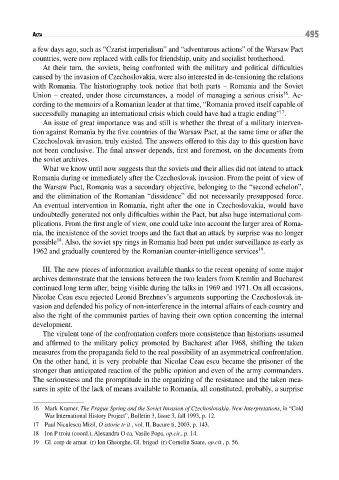Page 495 - Conflitti Militari e Popolazioni Civili - Tomo I
P. 495
495
aCta
a few days ago, such as “Czarist imperialism” and “adventurous actions” of the Warsaw Pact
countries, were now replaced with calls for friendship, unity and socialist brotherhood.
At their turn, the soviets, being confronted with the military and political difficulties
caused by the invasion of Czechoslovakia, were also interested in de-tensioning the relations
with Romania. The historiography took notice that both parts – Romania and the Soviet
16
Union – created, under those circumstances, a model of managing a serious crisis . ac-
cording to the memoirs of a Romanian leader at that time, “Romania proved itself capable of
17
successfully managing an international crisis which could have had a tragic ending” .
An issue of great importance was and still is whether the threat of a military interven-
tion against Romania by the five countries of the Warsaw Pact, at the same time or after the
Czechoslovak invasion, truly existed. The answers offered to this day to this question have
not been conclusive. The final answer depends, first and foremost, on the documents from
the soviet archives.
What we know until now suggests that the soviets and their allies did not intend to attack
Romania during or immediately after the Czechoslovak invasion. From the point of view of
the Warsaw Pact, Romania was a secondary objective, belonging to the “second echelon”,
and the elimination of the Romanian “dissidence” did not necessarily presupposed force.
An eventual intervention in Romania, right after the one in Czechoslovakia, would have
undoubtedly generated not only difficulties within the Pact, but also huge international com-
plications. From the first angle of view, one could take into account the larger area of Roma-
nia, the inexistence of the soviet troops and the fact that an attack by surprise was no longer
18
possible . Also, the soviet spy rings in Romania had been put under surveillance as early as
1962 and gradually countered by the Romanian counter-intelligence services .
19
III. The new pieces of information available thanks to the recent opening of some major
archives demonstrate that the tensions between the two leaders from Kremlin and Bucharest
continued long term after, being visible during the talks in 1969 and 1971. On all occasions,
Nicolae Ceaučescu rejected Leonid Brezhnev’s arguments supporting the Czechoslovak in-
vasion and defended his policy of non-interference in the internal affairs of each country and
also the right of the communist parties of having their own option concerning the internal
development.
The virulent tone of the confrontation confers more consistence than historians assumed
and affirmed to the military policy promoted by Bucharest after 1968, shifting the taken
measures from the propaganda field to the real possibility of an asymmetrical confrontation.
On the other hand, it is very probable that Nicolae Ceaučescu became the prisoner of the
stronger than anticipated reaction of the public opinion and even of the army commanders.
The seriousness and the promptitude in the organizing of the resistance and the taken mea-
sures in spite of the lack of means available to Romania, all constituted, probably, a surprise
16 Mark Kramer, The Prague Spring and the Soviet Invasion of Czechoslovakia. New Interpretations, în “Cold
War International History Project”, Bulletin 3, Issue 3, fall 1993, p. 12.
17 Paul Niculescu Mizil, O istorie trόitό, vol. II, Bucurečti, 2003, p. 143.
18 Ion Pčtroiu (coord.), Alexandru Očca, Vasile Popa, op.cit., p. 14.
19 Gl. corp de armatč (r) Ion Gheorghe, Gl. brigadč (r) Corneliu Soare, op.cit., p. 56.

